|
A New Order After the death of William Butler, Mr.
Laurence Hodson became Chairman. He had a thorough knowledge
of all aspects of the business, after being head of the
manufacturing department for several years. The directors
were Mr. Samuel Butler, Mr. F. T. Langley, and Mr. W. R.
Wilson. Major T. Addenbrooke was appointed to replace the
late Mr. W. Holland as company secretary. He immediately set
about reorganising the office staff and improving their
systems of working, which were thoroughly disorganised. |
|
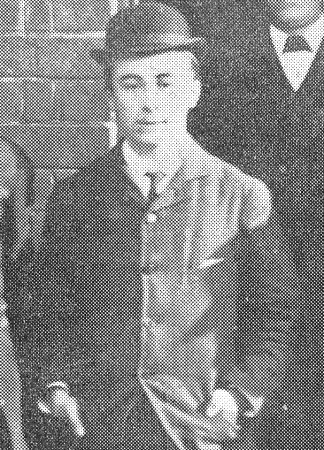
Laurence Hodson. |
In 1895 the twelve hour shift system
was abandoned. It had proved to be too hard for many of the
staff, and so was replaced by a system of three eight hour
shifts.
In the same year a new building
programme began. A property maintenance depot opened on the
east side of Cambridge Street to carry out alterations and
repairs to the company’s public houses, and to the brewery
itself, and a new water pumping house opened on the western
boundary of the site.
In 1896 new buildings included a
well-equipped cooperage and a cask washing shed at the
northern end of the site, and a boiler house. The cooperage
consisted of a range of small workshops for the making and
repair of casks.
Several other new buildings were
constructed including a cellar with a fermenting room above,
lined with glazed tiles for cleanliness; ale storage sheds,
spacious offices, an entrance into Cambridge Street, and a
paved yard with granite setts. The fermenting room which had
a capacity of 1,250 barrels per week was designed by Mr.
Pryce, the building surveyor and his staff, in consultation
with Mr. Hodson, and Mr. Beal the head brewer. Extra
flooring was built on the first floor of the new brewery,
and two more twenty five quarter mash tuns were installed. |
| A view of the brewery from the
London & North Western Railway in 1899.
From the Wolverhampton and South
Staffordshire Illustrated. |
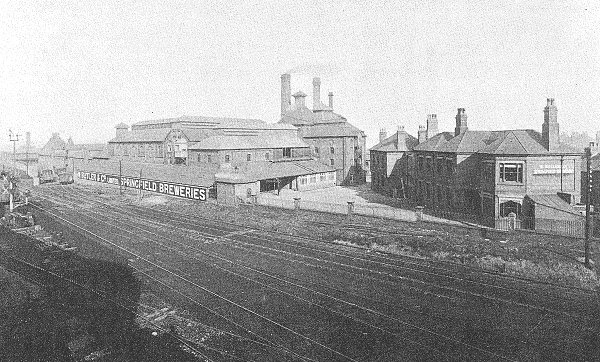 |
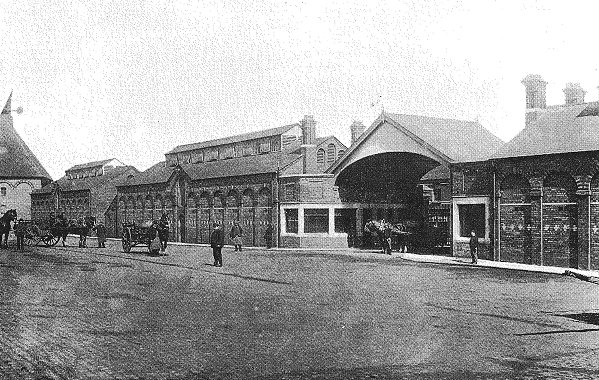 |
The stables in 1899.
From the Wolverhampton and South
Staffordshire Illustrated. |
| Mash tuns.
From the Wolverhampton and South
Staffordshire Illustrated. |
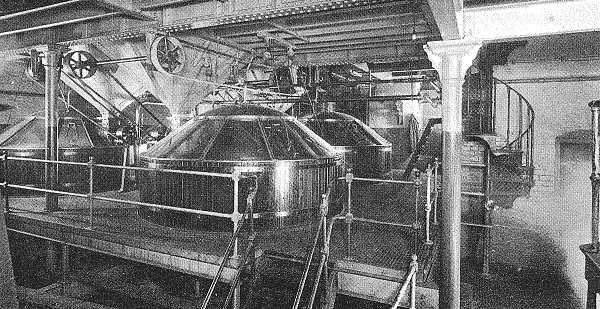 |
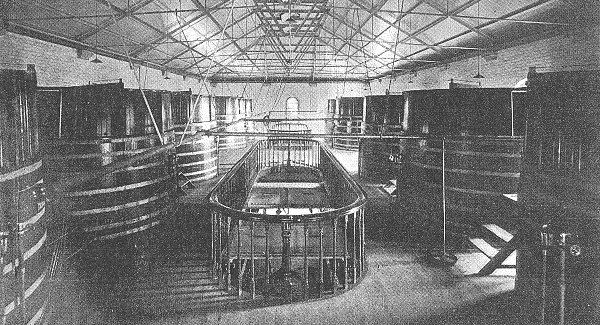 |
The collecting floor in the new
tun room. From the
Wolverhampton and South Staffordshire Illustrated. |
|
The forwarding department in the front
yard was reorganised. Loading operations were slow,
dangerous and hopelessly congested. In order to streamline
the loading process a loading bay was built facing the
stables on the eastern side of the site.
By the late 1890s the brewery had been
fitted with fire appliances including standpipes, hydrants,
and long hoses capable of reaching any part of the site. A
large number of men were trained in the use of the
appliances, in case of an emergency. The appliances were
supplied by Merryweather & Company, fire engine and fire
equipment manufacturers, based at Greenwich.
By the turn of the century the brewery
employed 300 people, including a number of blacksmiths who
worked at the company’s up-to-date smithies.
There was a
large cooperage, complete with all the necessary machinery
and appliances, a modern brewery capable of producing 3,500
barrels per week, a fine paved yard with a loading stage,
and a range of splendid offices. |

Mr. W. R. Wilson. |
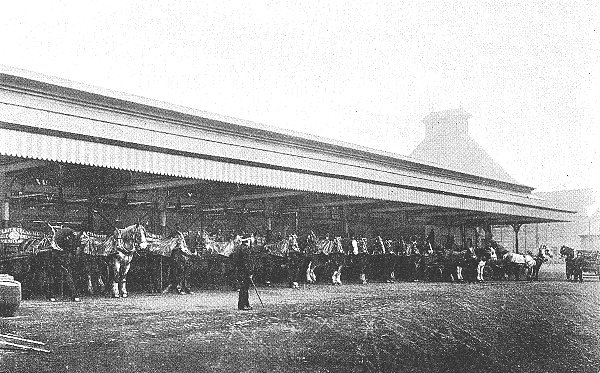 |
The loading Shed.
From the Wolverhampton and South
Staffordshire Illustrated. |
| The cooperage.
From the Wolverhampton and South
Staffordshire Illustrated. |
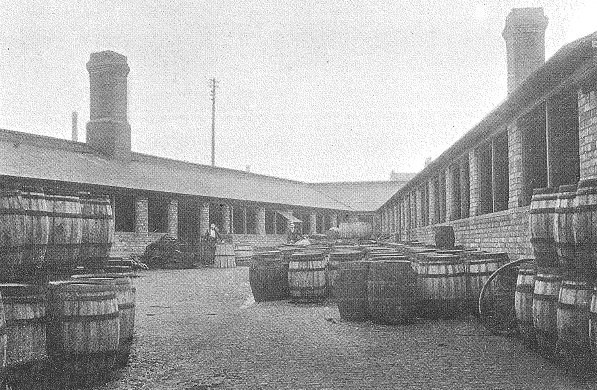 |
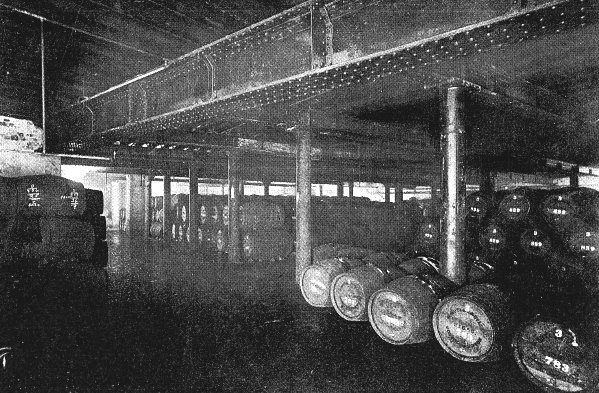 |
The cellars.
From the Wolverhampton and South
Staffordshire Illustrated. |
| The cask washing shed.
From the Wolverhampton and South
Staffordshire Illustrated. |
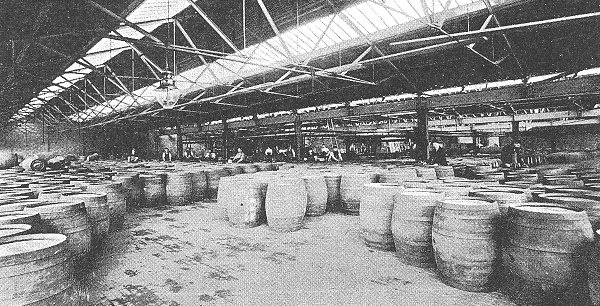 |
 |
Further building work took place in 1899. Another two
mash tuns, made by Robert Morton & Company, brewers'
engineers of Burton on Trent were installed, bringing the
total up to six.
An extension was built on the eastern side of the new
brewery to contain four 50 barrel coppers, and a hop back.
On the northern side of the building, a cooler and
refrigeration room was added. The new plant increased the
brewery's capacity to 4,000 barrels per week.
Reconstruction and refitting also took place in the
fermenting rooms in the old maltings.
An ale store with
a cellar below was added on the western side of the
building, while on the east, the new extension included a
yeast floor, a skimming floor, and a collecting floor.
Another addition, which still stands today, is a the
entrance and gateway in Cambridge Street. |
| On 19th August, 1905 Samuel Fellows
left the company where he had worked for over thirty years.
He began as a clerk and subsequently became a departmental
manager. In 1908 he wrote his history of the company, the
only detailed history of its early years. He studied
mathematics and astronomy, and became a member of the Royal
Astronomical Society. He also gave talks on astronomy, and
wrote many articles on the subject. He died on 3rd July
1937. |
|
The skimming room.
From the Wolverhampton and South
Staffordshire Illustrated. |
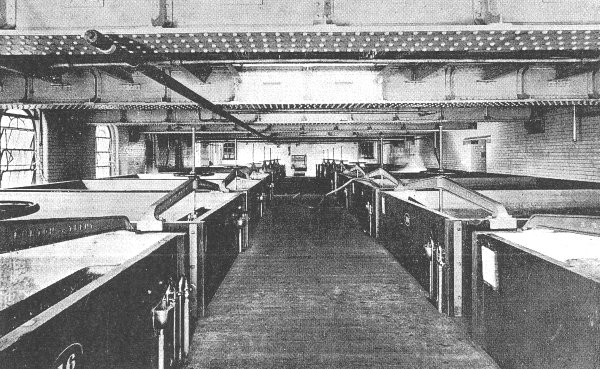 |
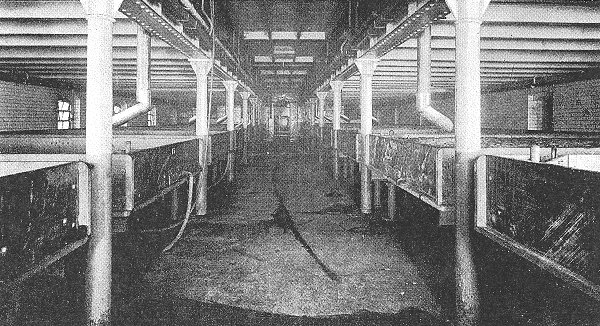 |
The yeast floor in the new tun
room. From the Wolverhampton
and South Staffordshire Illustrated. |
|
On 26th April, 1906 Mr. Lawrence Hodson
resigned as company Chairman, severed his connection with
the brewery, and soon left the district. He was succeeded as
Chairman by Mr. William Frank Wilson. Also in 1906 his son Mr. W. R. Wilson
took charge of the brewery.
The Wilsons had been London-based
brewers since the late 17th century, and were head
brewers at Combe, Delafield & Company of Castle Street, Long
Acre, London. Mr. W. F. Wilson had a distinguished career in
the brewing industry. He was student at the London College
of Science, and studied chemistry under Professor Hofmann
before joining Combes, where he succeeded his father as head
brewer in 1868. He was possibly one of the best brewers in
the country, and instrumental in starting the Laboratory
Club, which later became the Brewers Institute. When the Wilsons moved to the Midlands they
purchased 'Elmhurst', a fine house in Wood Road, Tettenhall,
which still survives.
During 1906 an increasing level of
carbonate in the spring water led the brewery to introduce
piped water from the town supply. The five existing wells
were abandoned, and town water was stored in a new tank,
built over the southern end of the old brewhouse.
In 1907 the head brewer Mr. Hall left
the brewery, and was succeeded by Mr. Arthur Hodson. Around
the same time Mr. S. Bayliss was appointed to the Board.
Sadly Mr. Arthur Hodson died in 1911 and was replaced by Mr.
R. L. Siau, who had been with the company since 1903. |
 |
|
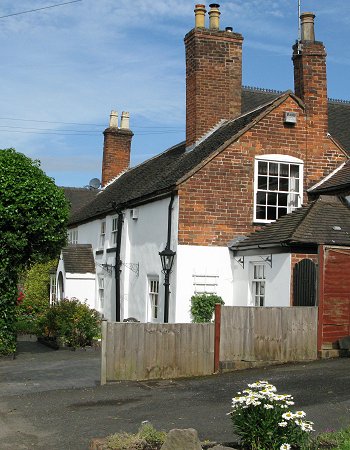 |
| Captain
Theodore Addenbrooke. From Butler's Magazine, March 1925. |
|
Captain Addenbrooke
lived at
'Pennover' in Vicarage Road, Penn. |
|
 |
|
 |
|
 |
Return to
Bereavements |
|
Return to
the beginning |
|
Proceed to
Acquisitions |
|